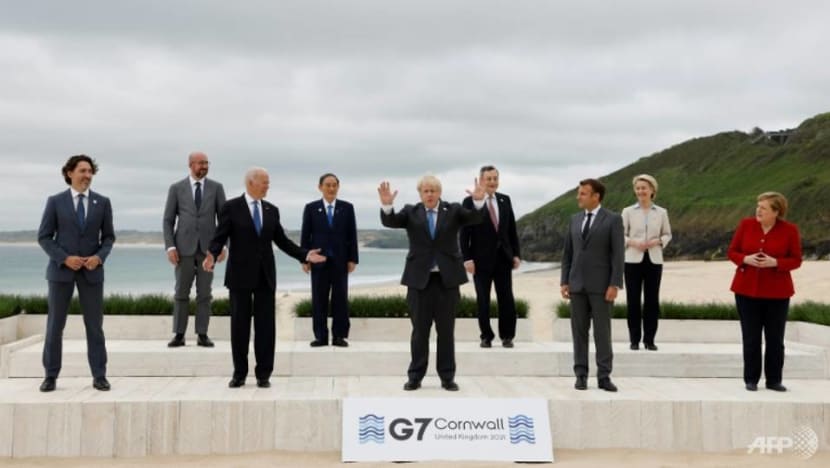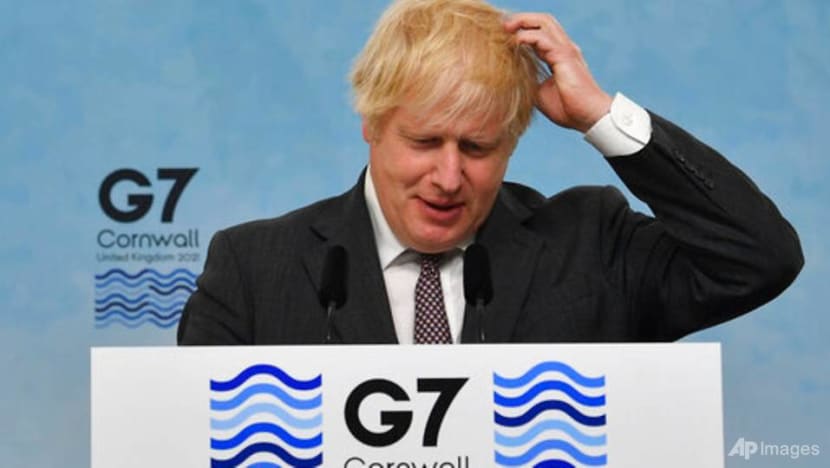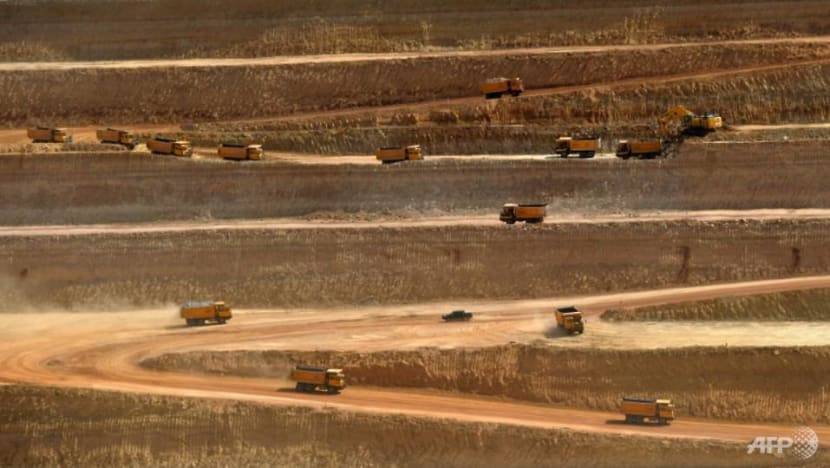Commentary: Did the world just get a second Belt and Road Initiative?
The Build Back Better World plan builds on past US efforts to boost international infrastructure financing and is not necessarily aimed at countering China’s Belt and Road Initiative, says Andre Wheeler.

China has slammed G7 leaders after they criticized Beijing's human rights record in Xinjiang and Hong Kong AFP/Ludovic MARIN
HONG KONG: There has been much hype around the announcement by the G7 of the Build Back Better World (B3W) initiative as a counter measure to China’s Belt and Road Initiative (BRI).
But a nuanced understanding of the B3W reveals a more complex set of objectives depending on who you ask.
For one, the B3W is not new.
While hailed as a new initiative under the Joe Biden administration, the idea of an alternative infrastructure programme to China’s was initiated under President Donald Trump ‘s administration under the ambit of the bipartisan Better Utilisation of Investments to Development (BUILD) Act passed by the House and Senate and signed into law by Trump in 2018.
READ: Commentary: G7 summit proved the world has shifted after Trump
READ: Commentary: We need to talk about how Donald Trump’s presidency wasn’t a complete disaster
BUILDING ON THE BUILD ACT
Central to the BUILD programme was less the objective of countering China and more the aim to encourage private sector investment into developing countries that would reduce the need for US foreign aid.
The focus was on funding hard infrastructure, such as electricity, that would help less developed countries attract investment to grow their way out of poverty.
The BUILD Act also had the mandate to invest up to US$60 billion in private sector investment to fight extreme poverty.
The US would do this by converting the US Overseas Private Investment Corporation (OPIC) into a new international Development Finance Corporation (USIDFC) with modernised financing capabilities, including the ability to provide equity financing, local currency loans and guarantees.

This new USIDFC, established under the BUILD Act, would make loans, invest in and forge partnerships with those wanting to do business in low- to middle-income countries as a minority investor.
MOUDLING INTERNATIONAL INFRASTRUCTURE FINANCING
It was only in 2019 that the USIDFC gained international muscle through the mooting of a Blue Dot Network (BDN) in which the US joined forces with Japan and Australia but remained open to other countries joining the network in supporting high-quality, private sector led investments.
Framed in terms of countering Chinese influence under an Indo-Pacific strategy, the BDN would indeed offer an alternative to China’s BRI and tap into the US$1.3 trillion dollars in trade volume between China and the countries along the BRI in 2018.
It would fill the demand for international infrastructure financing with a US model through mobilising private capital while giving governments skin in the game in mitigating endemic risks including political, legal and social risks.
But it was clear the three countries couldn’t do it on their own. Enter the B3W.
The B3W is an extension of the BDN. At a high level, the B3W and BDN appear to be guided by similar policy and principal guidelines in meeting the development needs of the poorer countries subscribing to agreed standards like the G20 Principles for Quality Infrastructure Investment endorsed in Osaka in 2019.
By mobilising private sector capital, the B3W’s funding is aimed at addressing four specific areas (i.e., climate, health, digital technology, and gender equity), enlisting an ”alliance of democracies” to project soft power driven by common values, good governance and established standards.
READ: Commentary: The US needs a new China strategy
READ: Commentary: Joe Biden’s quietly revolutionary first 100 days
Indeed, the B3W announcement has been positioned as a “democratic” alternative to the BRI and a foreign policy move by the US to showcase President Biden’s foreign relations credentials, signal that the US is back and shore up the US’s influence in transatlantic relations, after a dismal four years under Trump.
But even amid all that puffery, US allies are wary of isolating China, with UK Prime Minister Boris Johnson at the G7 expressing a desire to frame this as a “green BRI” granting access to financing for low-carbon projects like clean energy that “shows who we are, not who we are against”.

While planning to offer a US$100 billion a year in alterative loans, the G7 has collectively signalled it is more keen on a path forward less seen as a challenge of China and more a framework in which G7 nations can still engage with China.
Even within the US, some politicians rather call this the “Green Marshall Plan”, to avoid demonising the BRI.
THE DRAWBACKS OF THE B3W
Perhaps the better question is whether the B3W can credibly rival the BRI. The answer is less certain. The B3W after all is playing catch-up. Being a nascent idea, the B3W naturally lacks a clear pathway forward that helps developing countries access global trade and build their respective economies.
In comparison, the eight-year-old BRI has an integrated, regional infrastructure development plan based on supply chain considerations connecting markets via integrated port-rail-road transport networks.
READ: Commentary: Just how much do China’s Belt and Road projects benefit recipient countries?
READ: Commentary: We sure believe some weird stuff about China's Belt and Road Initiative
Not only has the BRI created employment in local markets in the construction phase, it has also facilitated commercial sustainability by enhancing access to export markets.
Another advantage that the BRI has is the Digital Silk Road that overlays the BRI, digitally connecting even the most remote of markets, with BRI countries obliged to use the digital network and standards of China when doing trade. But the B3W does not impose this level of integration.
The challenge also is how the B3W will treat projects with significant carbon footprints commonplace in developing countries.
Under the B3W investment criteria, there would be no funding given to coal-fired power stations but developing countries might have few credible energy alternatives. Meanwhile, under China’s BRI green investment guidelines, funding would be given to high-efficiency low-emissions coal power stations.
READ: Commentary: China’s foreign loans, as a recent study shows, is full of ‘Chinese characteristics’
It also remains unclear whether the B3W private sector funding model, funded by patient capital including pension funds, insurance companies and other private investors, will be able to catalyse development on the scale of the BRI, which uses China’s vast foreign exchange reserves and financing from state banks to back projects.
For now, it is difficult to see how the B3W can rival the cooperation agreements with 140 countries and 31 international organisations enjoyed by China’s BRI.
TIMING IS EVERYTHING
Then again, COVID-19 has exposed a number of shortcomings of the BRI, particularly with 20 per cent of BRI projects being put on hold.

These project delays have highlighted the fundamental problem afflicting many BRI projects of a lack of upfront due diligence with the result being that many BRI projects have often simply traded speed early in the project cycle for far more difficult problems later.
Tied financing that favour the use of Chinese contractors and opaque practices have also been associated with cost blow-outs and corruption scandals, most infamously in the case of the East Coast Rail Link project in Malaysia.
And with several countries now challenging China’s claims that BRI had been built on mutual respect, strong people-to-people bonds and non-interference in national sovereignty, there is a window of opportunity for the B3W to make itself more relevant.
Andre Wheeler is chief executive of Asia Pacific Connex and has 20 years of international business experience in the US and Asia-Pacific.















